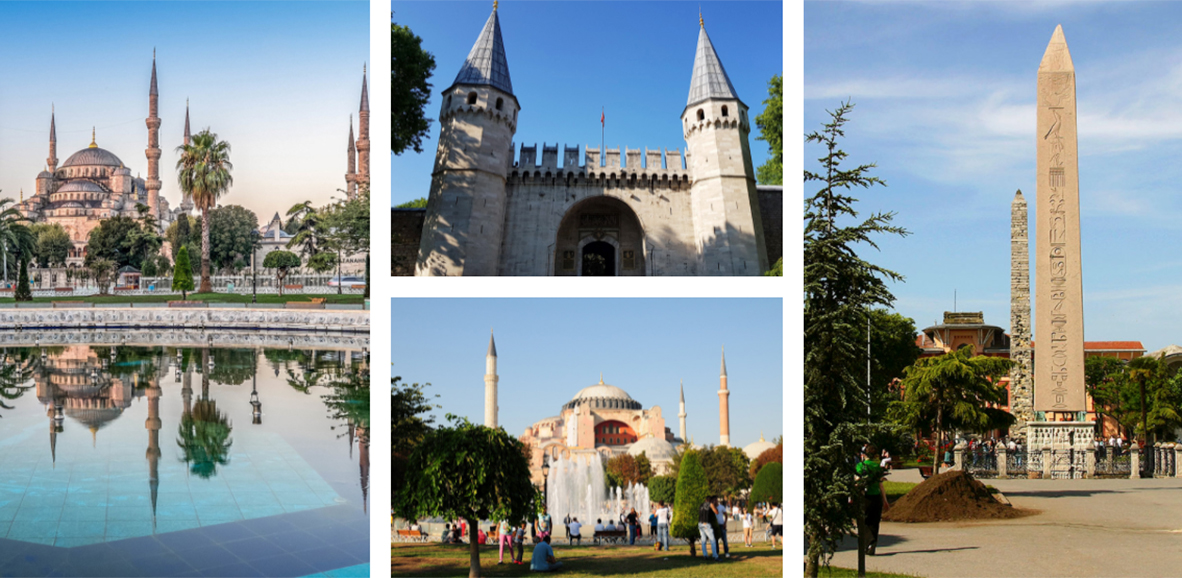The Hippodrome is much more ancient than the city of Constantinople, which people often consider as its birthplace. The first Hippodrome was erected when Byzantium was a minor provincial town. Emperor Septimius Severus rebuilt and extended the city’s walls in AD 203, building a hippodrome for chariot races and other amusements.
The Emperor Constantine the Great redrew Byzantium in AD 324 after his victory at the nearby Battle of Chrysopolis, renaming it Nova Roma (New Rome). The city was nicknamed Constantinople, City of Constantine, due to this name’s inability to impress. Constantine greatly expanded the city; one of his major projects was restoring the Hippodrome.
The Hippodrome of Constantine was thought to be around 450 meters long and 130 meters broad. The starting gates were positioned at the northern end; and the sphendone (curved tribune of the U-shaped structure, the lower part of which still survives) stood at the southern end. Various monuments such on as a monolithic obelisk, which was erected in honor of Emperor Constantius II (337–361), were placed along the spina (middle barrier).
The arena’s stands could hold 100,000 people. The race track at the Hippodrome was U-shaped, and the Kathisma (emperor’s lodge) was located at the eastern end of the course. The Byzantine emperor or other imperial family members could enter the Kathisma directly from the Great Palace via a tunnel that only they had access to.
The city’s sack in 1204 marked a turning point for ancient Constantinople, which never truly recovered from the Fourth Crusade and even though the Byzantine Empire survived until 1453, by then the Hippodrome had been destroyed, pillaged by the Venetians who may have taken one of the four horses now at San Marco from another monument there.
The Ottomans, who conquered the city in 1453 and made it the Ottoman Empire’s capital, had no interest in chariot racing and little attention was paid to the Hippodrome over time. The hippodrome served as a source for construction material.
At various events, the Hippodrome was utilized including the Sultan Ahmed III’s lavish and days-long circumcision ceremony. The Hippodrome is depicted in Ottoman miniature paintings with the seats and monuments still intact. Although the buildings no longer exist, today’s Sultanahmet Square follows much of the original ground plan and size of the now vanished Hippodrome.
There are many monuments around the Hippodrome area. The most striking is the Egyptian Obelisk, originally constructed by Pharaoh Tutmosis III (1549-1503 BC). It was 200 feet high and weighed 800 tons, but when shipped from Egypt to Constantinople it broke in three pieces and only top of it survived. The obelisk was erected in 390 AD during the reign of Theodosius I. The marble base holds sculptured reliefs that depict the Emperor’s watching a chariot race with his family. It is made of pink granite and it depicts Pharaoh Tutmosis III with Sun God Amon Ra.
Another monument in the hippodrome is a column made from three bronze serpents intertwined. It was brought over from Temple of Apollo, Delphi, Greece.
The third monument in this area is called “Colossus” or “The Column of Constantine”. In contrast to the Obelisk, it appears more eroded and researchers believe its purpose has parallels with Egyptian Obelisk.
The last monument in the Hippodrome Area is the German Fountain or “Fountain of Kaiser Wilhelm II”. It is an octagonal building with taps around which was constructed in 1898. There are lovely mosaics inside that depict the signatures of Emperor William II and Sultan Abdulhamit II.



Comment (0)